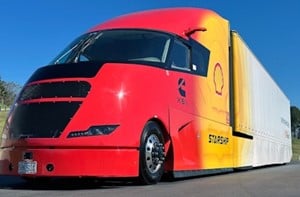The Shell Starship 3.0 NG is not just another tractor; it represents a significant advancement in the trucking industry with its cutting-edge Cummins X15N natural gas engine. This pioneering engine is the first of its kind in the large-bore category and can operate on renewable natural gas when available, aligning with the industry’s push for sustainability. With a design focused on meeting stringent regulations, the Starship promises reduced emissions, lower fuel costs, and enhanced reliability.
When the Starship was first revealed about six years ago, its unconventional design turned heads, resembling something out of a futuristic car show rather than a typical semi. Back then, it boasted an impressive 8.94 miles per gallon—a remarkable feat that has since paved the way for many drivers who now routinely exceed 9 or even 10 mpg. Even more impressive, the Starship achieved an average freight ton efficiency of 178.4 ton-miles per gallon, which is a staggering 248% improvement over the Class 8 industry average of 72 ton-mpg.
Now in its third iteration, the Shell Starship has made significant strides in freight ton efficiency, achieving 2.542 times better performance in ton-miles per gallon and 3.23 times better when considering emissions measured in CO2e. While the latest model has a fuel efficiency of 9 mpg diesel gallon equivalent, this is expected with natural gas engines. However, Kevin Otto, the electrification team lead for the North American Council for Freight Efficiency (NACFE), notes that the tradeoff is worthwhile, as the engine requires less maintenance and offers lower emissions.
Shell’s commitment to cleaner emissions and alternative fuels is evident in the design of this truck. Heather Duffey, the global integrated communications manager for Shell Commercial Road Transport Lubricants, emphasized the importance of having infrastructure to support this innovation. While hydrogen was briefly considered, natural gas emerged as the clear choice due to its immediate availability for fleets. The Starship serves as a testing ground to demonstrate the potential of existing technologies that can be easily adopted by trucking companies today.
As a “lab on wheels,” the Starship validates various innovations, such as the effectiveness of low-viscosity oils and lubricants designed for alternative fuel powertrains. For instance, it utilizes Shell Rotella NG Plus SAE 5W-30 FA-4 synthetic engine oil, which reduces friction and flow resistance, ultimately enhancing fuel economy without compromising protection. Additionally, the truck’s automated manual Eaton transmission is equipped with Shell Spirax S6 GME 40, a lubricant specifically engineered for high-torque applications.
Although the Starship showcases advanced technology, it remains accessible. Duffey points out that trucking companies are unlikely to invest in entirely new models without seeing tangible results first. The features that make the Starship unique—like its custom carbon fiber cab—are not just gimmicks; they are indicative of advancements that fleets can integrate into their existing operations.
Upon stepping inside the cab, drivers are met with a spacious environment reminiscent of a luxury aircraft cockpit, complete with multiple screens for monitoring the vehicle’s performance. The panoramic view from the cab is impressive, facilitated by a massive windshield and a camera system that replaces traditional side mirrors. This design is a testament to the truck’s innovative approach to aerodynamics and visibility.
From the driver’s seat, the X15N engine delivers solid power, blending seamlessly into the driving experience. Eric Rector, one of the Starship co-pilots, has spent extensive time in the cab, logging thousands of miles. He shares that he has yet to notice a significant difference in performance between natural gas and diesel engines, emphasizing the practicality of the alternative fuel.
The ability to use renewable natural gas (RNG)—derived from organic waste—offers a substantial advantage for emissions reduction. While RNG can be challenging to source, Compressed Natural Gas (CNG) remains a feasible alternative for many fleets.
The discussion around alternative fuels often overlooks the real-world applicability of natural gas compared to battery electric solutions. Shell’s Starship demonstrates that viable options exist that won’t financially strain motor carriers while significantly reducing emissions. As the trucking industry navigates current freight challenges, the Starship’s focus on efficiency and performance showcases a promising pathway forward.
Key Takeaways
- The Shell Starship 3.0 NG revolutionizes the trucking landscape with its innovative Cummins X15N natural gas engine.
- Achieving remarkable freight ton efficiency and lower emissions, this tractor is a pioneer in the industry.
- As a “lab on wheels,” the Starship proves that advanced technologies can be integrated into everyday trucking operations, making a significant impact on sustainability and efficiency.
This innovative approach not only emphasizes the importance of sustainability in trucking but also highlights practical solutions that drivers can leverage for a more efficient future.
Source: Jason Cannon/ Commercial Carrier Journal











